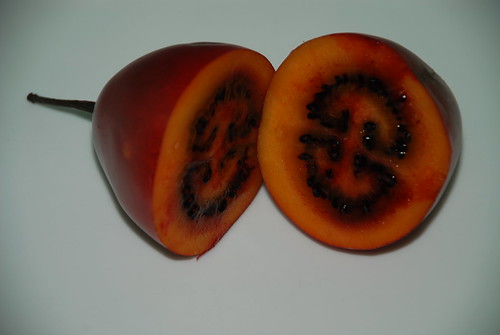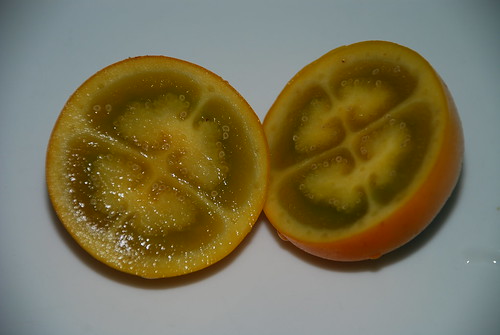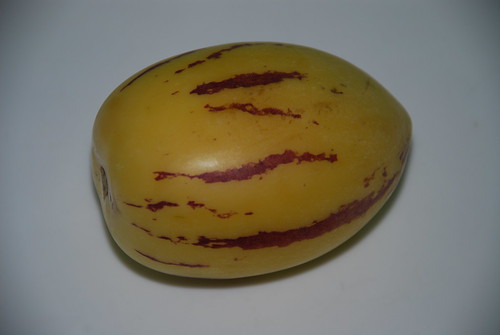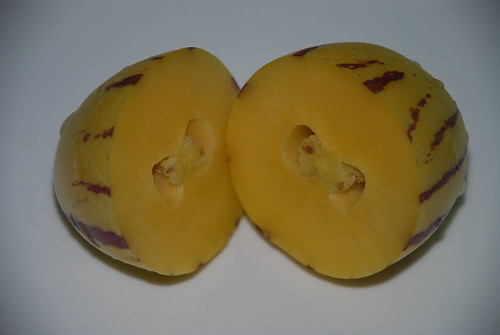So, the mission, which I've decided to accept, is to try as many of these exotic fruits (which are vegan, unless you blend them with milk in a batido) as possible. And, I'm going to document the effort, for the sake of posterity, and all of you who will soon be freezing and drinking cocoa instead of smoothies. (Have I mentioned that it's common to have cocoa AND juice for breakfast? That along with bread, cheese or jelly, and eggs, is desayuno simple. Desayuno completo, I gather, consists of chicken and rice.)
So, let's begin:
First, and probably most important in Ecuador, after ordinary things like strawberries, blackberries, pineapples, and oranges, is the TOMATE DE ARBOL:

It's not a tomato, but is slightly tomato-like in color, form, and flavor. It's a fruit that grows in a tree. When talking about juice you drop the arbol part and call it jugo de tomate, because nobody would be crazy enough to make juice out of actual tomatoes here. (I'm with 'em on that.) Here's what it looks like inside:

My first teacher here wrote me up some directions on eating all kinds of fruit, but I lost them. I remember that for most, you were supposed to peel them, and turn them into juice. I bought a basic vegetable peeler, but it isn't so helpful. While getting to know them, I'm skipping the juicing, and I'm assuming that, unless they're really easy to extract, you eat the seeds. So what's it like to eat a tomate de arbol?
It's soft but not mushy, plenty of sweetness but with tartness in equal measure, though not super-sweet or excessively sour. The flesh has a hint of tomato, definitely a bit vegetably, but the seeds have their own soft sweet flavor. Definitely could host vodka, perhaps as the base of a less hearty, happier version of a bloody mary.
OK, on to the NARANJILLA:

The name means little orange, but it's not a citrus fruit, and doesn't peel like one. Jugo de naranjilla is also really common.

It has a tart, slightly citrusy taste, but with a strong savory bite, like basil, which goes well with the firm flesh and slimy seeds reminiscent of a roma tomato.
Finally for tonight, PEPINO:

Small and firm, they're nothing like a pepper. Apparently some people find a similarity with melons and call them tree melons. The seeds are centrally located and easily removed.

It does have the texture of canteloupe, and a sweet, melony flavor, but with something that reminds me of sitting in the back yard late on a summer afternoon--the smell of snapping green beans next to a freshly mown lawn. It's pleasant, if a little odd coming from a fruit.
More after my next trip to the market.
4 comments:
are you vegan?
I gave veganism a shot for a couple of years. I've been pretty much vegetarian for, what, 12 years? Especially down here, I sometimes have to put up with some chicken broth so I don't starve, or try some seafood so as not to miss out on a complete area of the culture. It's interesting how meat has become ubiquitous in the poorest cultures that once subsisted on things like rice and beans.
My mouth, literally, is watering. I think I'll go eat a tomato like a fruit...right now.
I'm SO loving reading about all the fruits!!!
Post a Comment